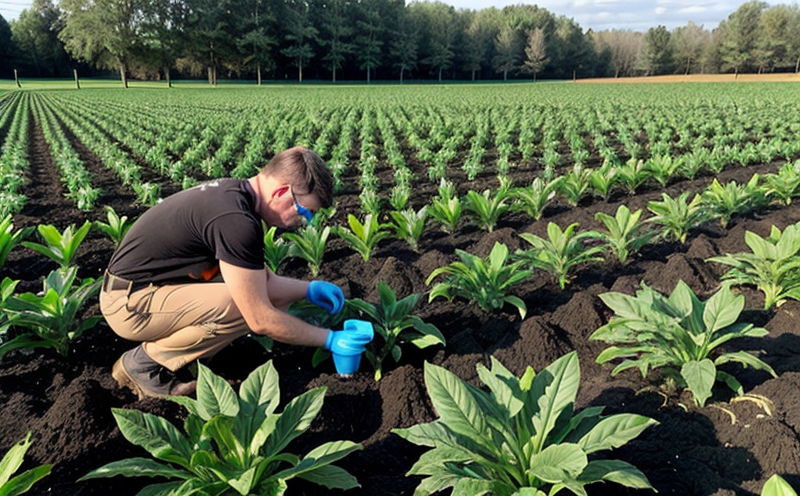Water-Solubility Testing of Fertilizer Nutrients
The water-solubility testing of fertilizer nutrients is a critical component in ensuring the effectiveness and safety of fertilizers used in agriculture. This test assesses how readily the essential nutrient components dissolve in water, which directly impacts their availability to plants for growth and development. Understanding this property helps in formulating fertilizers that are both efficient and environmentally friendly.
The process involves the use of standardized methods that ensure accurate measurement and comparability across different samples. The primary objective is to determine the percentage of each nutrient (such as nitrogen, phosphorus, potassium) that dissolves within a specified time frame under controlled conditions. This information is crucial for formulators and suppliers to optimize product formulations and meet regulatory standards.
The importance of water-solubility testing cannot be overstated in the agricultural sector. By ensuring high water solubility, we not only enhance crop yields but also minimize environmental pollution caused by excess nutrients leaching into groundwater or surface waters. This aligns with global sustainability goals aimed at reducing non-point source pollution and promoting sustainable farming practices.
During this testing procedure, samples are subjected to rigorous conditions that simulate real-world scenarios where fertilizers interact with soil moisture. The results provide insights into the immediate availability of nutrients, helping stakeholders make informed decisions about product selection and application rates.
The accuracy and consistency of these tests are paramount in maintaining industry standards and ensuring compliance with regulatory requirements worldwide. For instance, ISO 17240 provides guidelines for determining water-soluble nitrogen content in fertilizers, while other international standards like EN and ASTM offer additional protocols tailored to specific geographic regions.
Water solubility testing plays a pivotal role in the quality control processes of fertilizer manufacturers, ensuring that products meet both customer expectations and regulatory benchmarks. It also supports research and development efforts aimed at creating more effective and environmentally friendly fertilizers. By leveraging advanced analytical techniques such as spectrophotometry and atomic absorption spectroscopy (AAS), laboratories can achieve precise measurements necessary for accurate results.
Understanding the nuances of water-solubility testing allows us to appreciate its broader implications beyond just laboratory settings. In practical terms, it influences agricultural practices by guiding decisions related to optimal application rates and timing based on soil type and climate factors. Consequently, this leads to improved crop health and productivity while reducing unnecessary costs associated with over-application.
Moreover, the results from water-solubility tests contribute significantly towards environmental stewardship initiatives aimed at minimizing runoff into natural ecosystems. As sustainability becomes increasingly important in modern agriculture, reliable data derived through thorough testing procedures helps farmers adopt best management practices that promote long-term ecological balance.
In summary, water-solubility testing of fertilizer nutrients is an indispensable tool for ensuring product efficacy and environmental responsibility within the agricultural sector. Its relevance extends far beyond mere laboratory analysis; it shapes decision-making processes across various stakeholder groups involved in the production, distribution, and utilization of fertilizers.
Applied Standards
| Standard Number | Description |
|---|---|
| ISO 17240-1:2015 | Determination of water-soluble nitrogen in fertilizers - Part 1: General principles and requirements. |
| ASTM D3986-18 | Standard test methods for determination of total phosphorus content in phosphate rock. |
| EN 12577:2014 | Determination of potassium oxide (K₂O) content in potassic fertilizers by flame atomic absorption spectrometry (FAAS). |
| IEC 62321-1:2019 | Electrochemical measurement systems - Part 1: General requirements and test methods. |
The aforementioned standards provide comprehensive guidance for conducting water-solubility tests on fertilizers, ensuring that the procedures followed are consistent with international best practices. Compliance with these standards not only enhances credibility but also facilitates seamless integration into global supply chains.
Benefits
Conducting water-solubility testing offers numerous advantages to stakeholders in the agricultural and forestry sectors:
- Enhanced Product Quality: Ensures that fertilizers have optimal nutrient availability, leading to better crop performance.
- Regulatory Compliance: Meets stringent regulatory requirements set by governments around the world.
- Sustainability: Supports environmentally friendly practices by minimizing nutrient runoff and promoting efficient use of resources.
- Economic Efficiency: Helps in optimizing application rates, reducing waste, and lowering overall production costs.
- Research & Development: Provides valuable data for ongoing improvements in fertilizer formulations.
- Customer Satisfaction: Builds trust among consumers by delivering high-quality products that meet their needs effectively.
By incorporating water-solubility testing into their quality assurance programs, companies can gain competitive advantages and contribute positively to sustainable agricultural practices globally.





